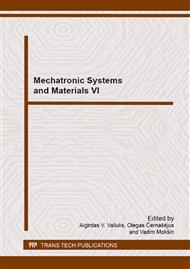p.451
p.457
p.463
p.470
p.479
p.485
p.491
p.497
p.504
Motion Analysis of Mechatronic Equipment Considering the Example of the Stewart Platform
Abstract:
Modern CAD/CAE allows supporting the process of design and construction at many stages, from concept development through specific engineering calculations to the creation of design documentation. In the case of constructing mechanisms, the kinematic and dynamic analysis of the proposed system is an important step in the introduced process. The paper presents an example of the kinematic and dynamic analysis of the Stewart platform using Siemens NX software [1, 2]. The conducted investigation has allowed determining the geometric characteristics of the mechanism of the Stewart platform as well as the geometric parameters of actuators and their location. A dynamic analysis of the platform helped with establishing the required motor forces for realizing the moves with the maximum speed and acceleration. This allowed the initial selection of the parameters of electric motors. Traffic analysis was also performed for investigating collisions between the parts of the hexapod and between the hexapod and its environment.
Info:
Periodical:
Pages:
479-484
Citation:
Online since:
January 2015
Authors:
Keywords:
Price:
Сopyright:
© 2015 Trans Tech Publications Ltd. All Rights Reserved
Share:
Citation:


